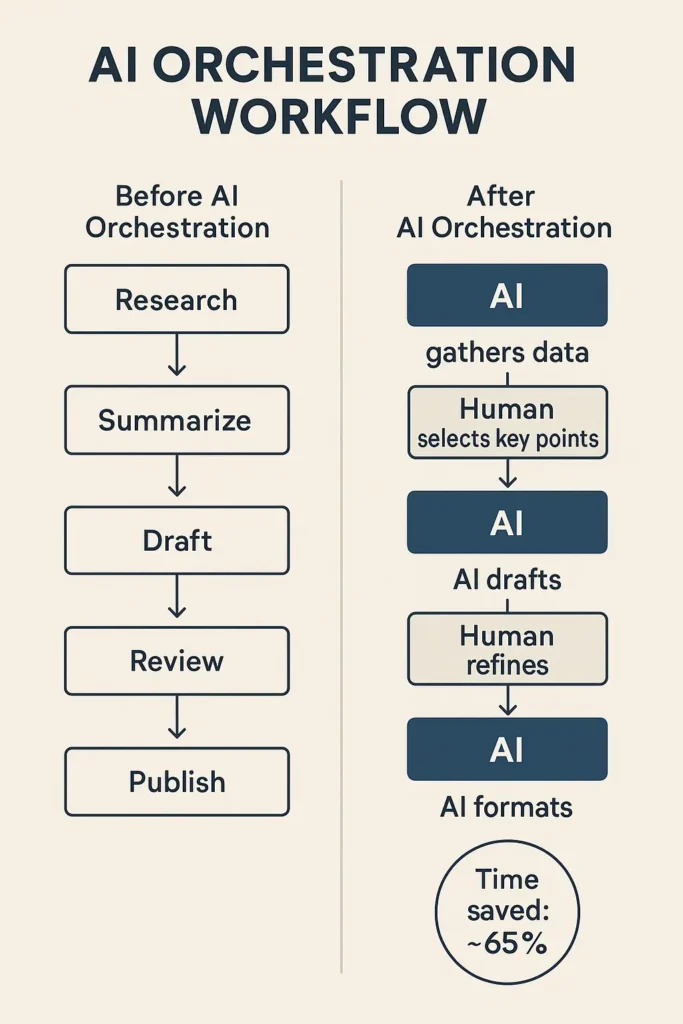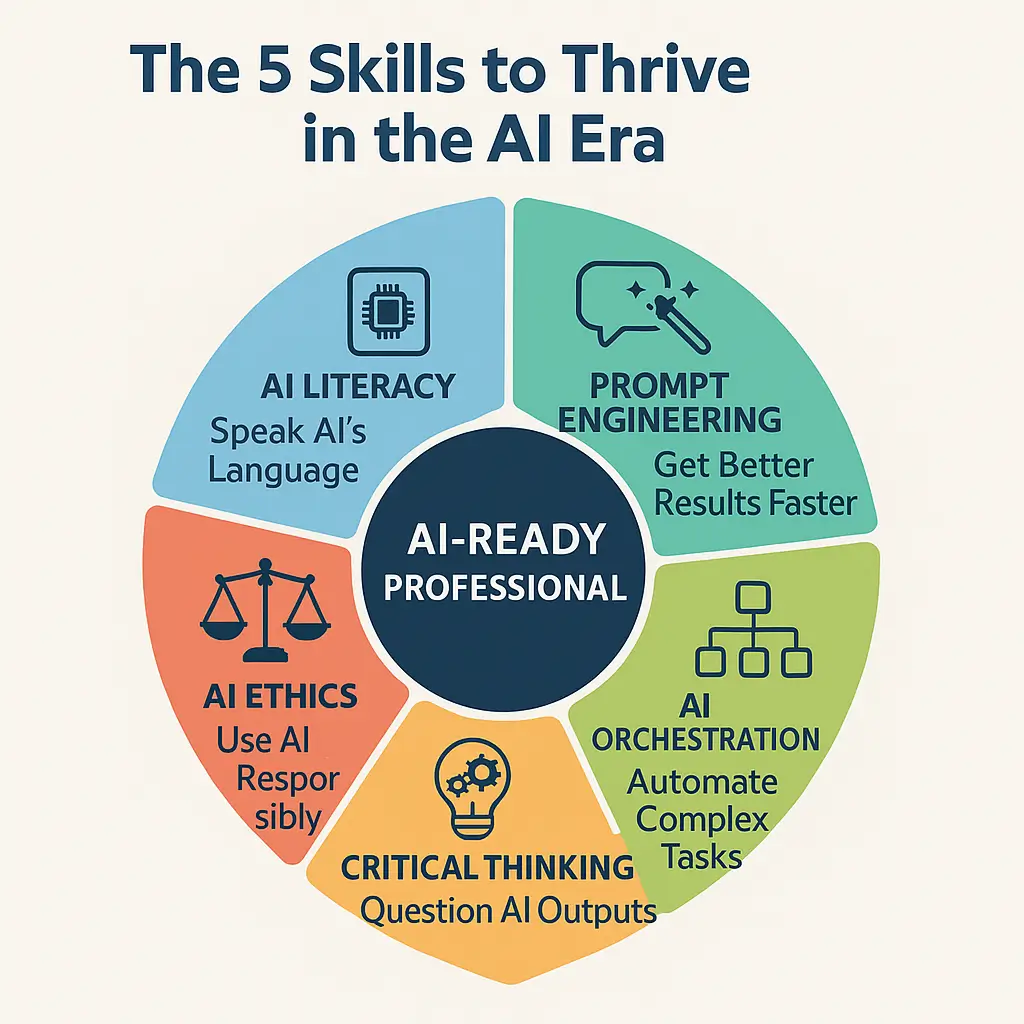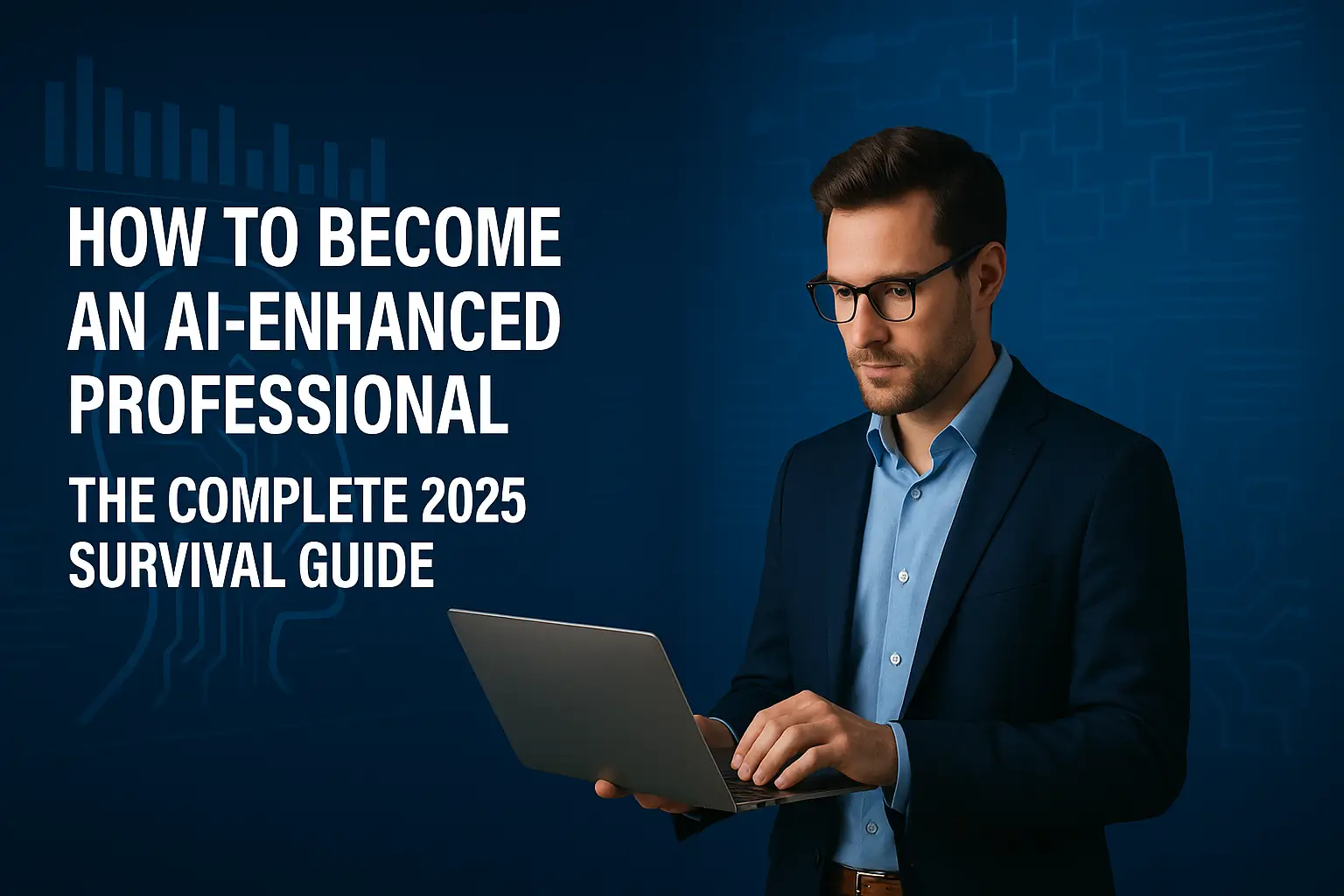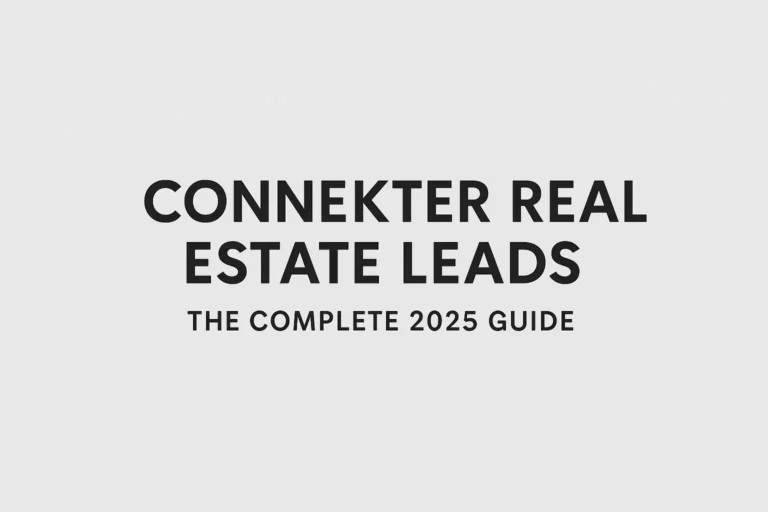How to Become an AI-Enhanced Professional: The Complete 2025 Survival Guide
By the end of 2025, 40% of professionals will rely on AI for at least one core task daily. The ones who thrive will do something completely different from everyone else.
Let me be honest with you: the workplace you knew just five years ago is disappearing. Fast.
If you’re feeling overwhelmed by the constant stream of AI announcements, wondering if you’ll still have a job in two years, or trying to figure out which AI skills actually matter, you’re not alone. I’ve been helping professionals navigate this transformation for the past three years, and I can tell you that the winners aren’t those with the fanciest tech backgrounds.
They’re the people who learned to work with AI instead of against it.
Why This Matters More Than You Think
Here’s what’s actually happening in workplaces right now: 99% of developers are actively building AI agents for their companies. Not experimenting. Building. This isn’t some distant future scenario anymore.
But here’s the thing that surprised me most while researching this topic: the professionals thriving in this new landscape aren’t necessarily the most tech-savvy ones. They’re the ones who figured out how to become what I call “AI-Enhanced Professionals” – people who amplify their natural human abilities through smart AI partnerships.
Think of it like having a brilliant research assistant, a lightning-fast analyst, and a creative brainstorming partner all rolled into one. Except they never get tired, never have bad days, and work 24/7.
What Makes AI Agents Different (And Why You Should Care)
Remember when software just sat there waiting for you to click buttons? AI agents are nothing like that.
These systems can:
- Plan complex, multi-step projects on their own
- Learn from every interaction they have
- Adapt when circumstances change
- Communicate with other AI systems to solve problems
Imagine having a team member who can research a market, analyze competitor data, draft a strategy document, and present findings – all while you sleep. That’s where we’re heading.
The professionals who understand how to manage and orchestrate these AI agents aren’t just staying relevant. They’re becoming indispensable.
The 5 Critical Skills That Will Make You Indispensable
1. Master the Art of AI Orchestration
Think of yourself as a conductor leading a digital orchestra. Your job isn’t to play every instrument – it’s to ensure everyone (humans and AI) plays their part perfectly.
Why This Matters to You: Master AI orchestration and you’ll coordinate complex projects faster than entire traditional teams. One skilled orchestrator can deliver results that previously required 5-10 people.
What this actually looks like in practice:
- You assign research tasks to AI while humans handle client relationships
- You monitor AI outputs and adjust their “instructions” for better results
- You coordinate multiple AI systems working on different parts of the same project
- You design workflows that can handle more AI agents as your projects grow
Industry-Specific Examples:
Healthcare: A hospital administrator orchestrates AI agents for patient scheduling, insurance verification, and staff optimization while nurses focus on patient care.
Finance: A wealth advisor coordinates AI for market analysis, portfolio optimization, and compliance reporting while building client relationships.
Marketing: A marketing director manages five different AI agents: one for social media content, another for email campaigns, one for market research, one for competitor analysis, and one for performance reporting. She spends her time orchestrating their work and focusing on strategy and client relationships.
Before vs. After AI Orchestration:

- Before: 5 people spending 3 days compiling quarterly reports
- After: 1 person coordinating 3 AI agents + 1 analyst, completed in 6 hours
🎯 Pro Tip: Start small with 2-3 AI tools handling different parts of one project. Master the handoffs between them before scaling up.
⚠️ Common Mistake: Trying to orchestrate too many AI agents before understanding how each one works individually.
2. Become a Prompt Engineering Expert
Here’s something most people get wrong about AI: they think it’s about asking better questions. It’s not. It’s about architecting precise instructions that guide AI systems toward exactly what you want.
Why This Matters to You: If you master this skill, you’ll get better AI outputs in half the time, meaning more impact with less rework. Plus, prompt engineers earn up to $180,000 annually.
The difference between amateur and expert prompt engineering:
Amateur approach: “Write a marketing email for our new product.”
Expert approach: “You’re a marketing expert writing to busy executives in the SaaS industry. Our new product is [specific details]. The recipient’s main pain point is [specific problem]. Write a 150-word email that opens with a relevant industry statistic, presents our solution in one clear sentence, includes social proof, and ends with a specific call-to-action. Use a confident but not pushy tone.”
Industry-Specific Applications:
Legal: A paralegal creates prompts that help AI summarize case law, draft contract clauses, and identify relevant precedents while maintaining legal accuracy.
Education: A curriculum designer uses AI to generate lesson plans, quiz questions, and differentiated learning materials for various student levels.
Sales: A sales manager develops prompts that help AI qualify leads, personalize outreach messages, and create follow-up sequences based on prospect behavior.
Advanced techniques you should learn:
- Context architecture (giving AI the background it needs)
- Chain-of-thought design (getting AI to “think” step by step)
- Error handling (what happens when AI doesn’t deliver what you expected)
- Domain-specific optimization (customizing prompts for your industry)
🎯 Quick Win: Create a prompt template library for your 5 most common tasks. Refine them weekly based on results.
⚠️ Common Mistake: Writing vague prompts and expecting AI to read your mind instead of being specific about format, tone, and requirements.
Essential Prompt Engineering Resources:
- PromptBase for tested prompt templates
- OpenAI’s Prompt Engineering Guide
- FlowGPT community prompts
- Anthropic’s prompt library for Claude
3. Build Rock-Solid AI Literacy
AI literacy today is like computer literacy was in the 1990s. It’s quickly becoming non-negotiable.
Why This Matters to You: AI-literate professionals make better decisions faster and avoid costly AI implementation mistakes that can derail projects and damage careers.
But here’s what AI literacy actually means in practical terms:
Technical foundation (you don’t need to code, but you need to understand):
- How machine learning actually works at a basic level
- Why some AI tools are better for creative tasks while others excel at analysis
- What neural networks can and can’t do
- How to interpret AI-generated insights and apply them to real business decisions
Industry-Specific AI Literacy Examples:
Healthcare: A nurse manager understands which AI tools can help with patient education materials and which require human oversight for medical accuracy.
Finance: An analyst knows when to trust AI for data processing vs. when human judgment is needed for market interpretation.
Real Estate: An agent understands how AI can enhance property valuations while recognizing when local market knowledge trumps algorithmic assessments.
Practical proficiency:
- Hands-on experience with tools like ChatGPT, Claude, and industry-specific AI platforms
- Understanding when to trust AI recommendations and when to double-check them
- Recognizing AI biases and knowing how to work around them
Strategic application:
- Knowing which tasks to automate and which to keep human
- Understanding how AI impacts your specific industry
- Identifying opportunities where AI could solve existing business problems
🎯 Pro Tip: Spend 15 minutes daily experimenting with one AI tool. Document what works and what doesn’t for future reference.
⚠️ Common Mistake: Assuming all AI tools work the same way. Each has unique strengths and optimal use cases.
AI Literacy Learning Resources:
- DeepLearning.AI’s “AI for Everyone” course
- Google’s “Machine Learning Crash Course”
- Andrew Ng’s AI Newsletter
- MIT’s Introduction to AI online course
4. Develop Human-AI Teaming Skills
This is where it gets really interesting. The future workplace isn’t humans vs. AI. It’s humans working alongside AI as integrated teams.
Why This Matters to You: Professionals who excel at human-AI collaboration become indispensable because they multiply both human and AI capabilities. They become the bridge that makes AI actually work in real business contexts.
What successful human-AI collaboration actually looks like:
Trust calibration: You learn to trust AI for data analysis while relying on human judgment for sensitive client communications.
Communication bridge: You translate between what humans need and what AI can deliver. For example, your boss wants to “increase customer satisfaction,” and you know how to break that down into specific AI-measurable tasks.
Conflict resolution: When AI recommends one approach but your experience suggests another, you know how to evaluate both options systematically.
Shared mental models: You and your AI tools develop common frameworks for approaching problems together.
Industry-Specific Teaming Examples:
Consulting: A management consultant uses AI for market research and data analysis while focusing on client strategy sessions and change management.
Journalism: A reporter leverages AI for fact-checking and source verification while handling interviews and narrative crafting.
Project Management: A project manager coordinates AI tools for scheduling and resource optimization while managing team dynamics and stakeholder communication.
🎯 Quick Win: Identify one task where AI handles the analytical work and you provide the strategic interpretation. Practice this handoff until it feels natural.
⚠️ Common Mistake: Either over-trusting AI for tasks requiring human judgment or under-utilizing AI for tasks it handles better than humans.
Human-AI Teaming Tools:
- Zapier AI Actions for workflow automation
- Notion AI for collaborative planning
- Slack AI for team communication enhancement
- Microsoft Copilot for integrated office workflows
5. Amplify Your Emotional Intelligence
Here’s the counterintuitive part: as AI gets better at analytical tasks, your emotional intelligence becomes more valuable, not less.
Why This Matters to You: EQ is your ultimate competitive advantage. As AI commoditizes analytical skills, professionals with high emotional intelligence become irreplaceable because they can navigate the human elements that AI can’t touch.
Why emotional intelligence is your competitive advantage:
- AI can analyze sentiment in customer emails, but it can’t read between the lines in a tense client meeting
- AI can suggest optimal project timelines, but it can’t navigate team dynamics when deadlines get tight
- AI can identify market trends, but it can’t understand the human motivations driving those trends
Industry-Specific EI Applications:
Human Resources: An HR manager uses AI for resume screening and scheduling while personally handling sensitive employee conflicts and culture-building initiatives.
Sales: A sales director leverages AI for lead scoring and pipeline analysis while building deep relationships with key accounts and mentoring junior team members.
Customer Success: A customer success manager employs AI for usage analytics and churn prediction while personally managing escalations and expansion conversations.

Specific EI skills that matter most:
- Empathy and social perceptiveness for understanding what people really need (beyond what they say they need)
- Cultural intelligence for working with diverse teams and global AI implementations
- Ethical decision-making for situations where AI recommendations need human moral judgment
- Change leadership for helping teams adapt to AI-driven transformations
🎯 Pro Tip: Practice “AI emotional audits” – when AI suggests a communication or decision, ask yourself: “What human factors is AI missing here?”
⚠️ Common Mistake: Assuming AI can handle all “soft skills” tasks just because it can mimic human language patterns.
EI Development Resources:
- Harvard Business Review’s Emotional Intelligence courses
- Daniel Goleman’s EI assessment tools
- Crucial Conversations training for difficult dialogues
- Cultural intelligence assessments and development programs
Take This Quick AI Career Risk Assessment
Before diving into solutions, let’s see where you stand. Answer these 5 questions honestly:
1. Do you currently use AI tools for work-related tasks at least once per week?
- Yes: You’re ahead of 60% of professionals
- No: You’re at risk of being left behind
2. Can you write prompts that consistently get you the AI outputs you want?
- Yes: You have foundational prompt engineering skills
- No: This should be your first learning priority
3. Do you understand which tasks in your role are best handled by AI vs. humans?
- Yes: You’re developing strategic AI thinking
- No: Focus on AI literacy and workflow design
4. Are you comfortable explaining AI capabilities and limitations to colleagues?
- Yes: You’re positioned to become an internal AI leader
- No: Invest time in deepening your AI knowledge
5. Do you actively seek ways to integrate AI into your work processes?
- Yes: You have the right mindset for AI enhancement
- No: Start with small experiments to build confidence
Your Score:
- 4-5 Yes: You’re well-positioned but should focus on specialization
- 2-3 Yes: You’re making progress but need systematic skill development
- 0-1 Yes: You need to start immediately with foundational AI literacy
Solving the Real Problems You’re Facing
Let’s address the elephant in the room. You’re probably dealing with some specific challenges right now. Here’s how to tackle them:
AI Orchestration Workflow Visualization
Human Tasks AI Tasks Output
┌─────────────────┐ ┌─────────────────┐ ┌─────────────────┐
│ Strategic │ ──→ │ Data Collection │ ──→ │ Comprehensive │
│ Direction │ │ & Analysis │ │ Insights │
└─────────────────┘ └─────────────────┘ └─────────────────┘
│ │ │
▼ ▼ ▼
┌─────────────────┐ ┌─────────────────┐ ┌─────────────────┐
│ Quality Review │ ◄── │ Draft Creation │ ◄── │ Stakeholder │
│ & Refinement │ │ & Formatting │ │ Presentation │
└─────────────────┘ └─────────────────┘ └─────────────────┘
“I’m Overwhelmed by How Fast AI is Changing”
The problem: Every week there’s a new AI tool, and you feel like you’re falling behind before you even start.
The solution: Stop trying to learn everything. Focus on building a strong foundation first, then specialize.
Your 90-day action plan:
- Days 1-30: Focus solely on AI literacy basics and experiment with 2-3 main AI tools
- Days 31-60: Pick ONE specialized skill (I recommend prompt engineering) and practice it daily
- Days 61-90: Apply your skills to real work projects and document the results
Key insight: It’s better to be excellent at working with AI in general than to be mediocre at ten different AI tools.
“I’m Scared AI Will Replace My Job”
The reality check: Entry-level job postings have dropped 15% as AI automates routine tasks. But here’s what the statistics don’t tell you: AI is creating entirely new job categories.
The mindset shift you need: Think augmentation, not replacement.
The professionals thriving right now are:
- Customer service reps who use AI to handle routine inquiries while focusing on complex problem-solving
- Content creators who use AI for research and first drafts while adding human insight and creativity
- Project managers who coordinate both human teams and AI agents
- Analysts who combine AI data processing with human strategic thinking
Your protection strategy:
- Identify the parts of your job that require human judgment, creativity, or relationship building
- Use AI to handle the routine, time-consuming tasks
- Become known as the person who can get the best results from AI tools
- Document and share your AI-enhanced productivity gains
“My Company is Resistant to AI”
The common scenario: You want to develop AI skills, but your organization is slow to adopt new technologies or skeptical about AI.
Your stealth approach:
- Start with personal productivity improvements using AI tools that don’t require company approval
- Use AI for research, writing assistance, and learning new skills
- Document specific time savings and quality improvements
- Share success stories informally with colleagues
- Volunteer to research AI solutions for existing business problems
The result: You position yourself as an internal AI expert before your company even realizes it needs one.
“There’s Too Much Information and I Don’t Know What’s Worth Learning”
The curation strategy:
- Follow 3-5 key AI newsletters (not 20)
- Join 1-2 professional AI communities where you can ask specific questions
- Allocate exactly 30 minutes per week to AI learning (use a timer)
- Focus on developments relevant to your specific industry
- Implement “AI Learning Fridays” – Friday afternoon experimentation time
The meta-skill to develop: Learning how to learn continuously. This is more valuable than any specific AI tool knowledge.
Your Step-by-Step Implementation Plan
Phase 1: Foundation Building (Months 1-3)
Week 1-2: AI Literacy Bootcamp
- Complete one comprehensive AI literacy course
- Create accounts and experiment with ChatGPT, Claude, and one industry-specific AI tool
- Document your initial experiments and results
Week 3-6: Basic Prompt Engineering
- Practice writing prompts daily for work-related tasks
- Build a personal prompt library for your most common activities
- Join online communities focused on prompt engineering
Week 7-12: Practical Application
- Identify 3-5 routine tasks you can enhance with AI
- Implement AI solutions systematically
- Track time savings and quality improvements
- Share learnings with colleagues
Phase 2: Skill Application (Months 4-8)
Month 4-5: Workflow Integration
- Design AI-enhanced workflows for your major work processes
- Create templates and systems for consistent AI use
- Begin training colleagues on AI tools you’ve mastered
Month 6-8: Specialization Development
- Choose 1-2 advanced AI skills based on your role and interests
- Pursue targeted learning in these areas
- Lead small AI implementation projects
Phase 3: Expertise and Leadership (Months 9-12)
Month 9-10: Advanced Implementation
- Manage complex projects involving both AI tools and human teams
- Develop internal training materials or workshops
- Begin measuring business impact of your AI implementations
Month 11-12: Thought Leadership
- Share knowledge through internal presentations, blog posts, or speaking engagements
- Mentor other colleagues in AI adoption
- Position yourself as an AI change leader within your organization
Measuring Your Success (With Real Numbers)
Productivity Metrics to Track:
- Time saved through AI automation (aim for 20-30% reduction in routine tasks)
- Quality improvements in your outputs (fewer errors, deeper insights)
- Increased capacity for high-value work
- Number of colleagues you’ve helped adopt AI tools
Business Impact Metrics:
- Cost savings from AI implementation
- Revenue generation through AI-enhanced processes
- Customer satisfaction improvements from AI-supported services
- Recognition as an AI knowledge leader within your organization
Career Development Metrics:
- Salary increases or promotions attributed to AI skills
- New opportunities or responsibilities gained
- Industry recognition or speaking opportunities
- Network growth within AI professional communities
Advanced Implementation Toolkits:
For AI Orchestration:
- Zapier AI Actions for workflow automation
- LangChain for chaining AI operations
- ReAct (Reasoning + Acting) pattern guides
- Multi-agent framework tutorials
For Prompt Engineering:
- PromptBase marketplace for tested prompts
- OpenAI’s comprehensive prompt engineering guide
- FlowGPT community prompts and templates
- Anthropic’s Claude prompt library
For AI Literacy:
- DeepLearning.AI’s “AI for Everyone” course
- Google’s Machine Learning Crash Course
- MIT’s Introduction to AI online course
- Coursera’s AI for Business specialization
For Human-AI Teaming:
- Microsoft Copilot integration guides
- Notion AI collaborative workflows
- Slack AI for team communication
- Asana AI for project coordination
For Emotional Intelligence:
- Harvard Business Review’s EI assessment tools
- Daniel Goleman’s emotional intelligence resources
- Crucial Conversations training materials
- Cultural intelligence development programs
Trends to Watch in 2025-2026
Multi-Agent Ecosystems: Multiple AI agents will work together on complex projects, requiring new orchestration skills.
Embodied AI: AI systems will integrate with physical environments through robotics and IoT devices.
Regulatory Compliance: With new AI regulations, professionals with AI ethics and compliance expertise will become highly valuable.
Industry-Specific AI: Generic AI skills will become table stakes; specialized industry knowledge will command premium salaries.
Career Path Evolution
Traditional roles are transforming into hybrid positions:
- Marketing Professionals → AI-Enhanced Growth Strategists
- Project Managers → AI-Augmented Orchestrators
- Data Analysts → Human-AI Intelligence Teams
- Customer Service Representatives → AI-Supported Experience Designers
Your Next Steps (Start Today)
- This week: Sign up for ChatGPT or Claude and use it for one work task daily
- This month: Complete an AI literacy course and join one AI professional community
- Next 90 days: Implement the Phase 1 plan outlined above
- Next year: Position yourself as an AI expert within your organization
Remember: The goal isn’t to become a technologist. It’s to become a professional who uses AI to deliver better results, solve bigger problems, and create more value than ever before.
What’s Coming Next: Preparing for the Future
Trends to Watch in 2025-2026
Multi-Agent Ecosystems: Multiple AI agents will work together on complex projects, requiring new orchestration skills.
Embodied AI: AI systems will integrate with physical environments through robotics and IoT devices.
Regulatory Compliance: With new AI regulations, professionals with AI ethics and compliance expertise will become highly valuable.
Industry-Specific AI: Generic AI skills will become table stakes; specialized industry knowledge will command premium salaries.
Career Path Evolution
Traditional roles are transforming into hybrid positions:
- Marketing Professionals → AI-Enhanced Growth Strategists
- Project Managers → AI-Augmented Orchestrators
- Data Analysts → Human-AI Intelligence Teams
- Customer Service Representatives → AI-Supported Experience Designers
Your Next Steps (Start Today)
- This week: Sign up for ChatGPT or Claude and use it for one work task daily
- This month: Complete an AI literacy course and join one AI professional community
- Next 90 days: Implement the Phase 1 plan outlined above
- Next year: Position yourself as an AI expert within your organization
Remember: The goal isn’t to become a technologist. It’s to become a professional who uses AI to deliver better results, solve bigger problems, and create more value than ever before.
Why You’ll Win in the AI-Enhanced Future
Here’s something that might surprise you: the professionals who will dominate the AI era aren’t necessarily the most technically gifted. They’re the most adaptable.
You already have the most important skill for thriving in an AI world: the ability to learn, adapt, and apply new knowledge to solve real problems. Every challenge you’ve overcome in your career has prepared you for this moment.
The AI transformation is happening whether you participate or not. But here’s your advantage: while others are paralyzed by uncertainty or waiting for someone else to figure it out, you’re taking action. You’re building skills that will compound over months and years.
By the time AI becomes obviously essential in every workplace, you’ll have the experience, confidence, and expertise that new learners can’t quickly replicate. That’s not just job security – that’s career acceleration.
The question isn’t whether you’ll adapt to AI. It’s whether you’ll lead the transformation or let it leave you behind. Based on the fact that you’re reading this guide, I know which path you’ll choose.
Frequently Asked Questions: Your AI Career Concerns Answered
Q1: What’s the difference between using AI tools and being an “AI-Enhanced Professional”?
The short answer: It’s like the difference between knowing how to use a calculator versus being a financial analyst.
Using AI tools means you occasionally ask ChatGPT to help with emails or use AI to generate ideas. Being AI-Enhanced means you’ve designed systematic workflows where AI handles routine cognitive tasks while you focus on strategy, relationships, and creative problem-solving.
Real example: A basic AI user might ask ChatGPT to write a job description. An AI-Enhanced Professional has created a system where AI analyzes successful job postings in their industry, generates multiple variations optimized for different platforms, suggests salary ranges based on market data, and creates interview question templates – all while they focus on defining the role’s strategic importance and cultural fit requirements.
The key difference: Strategic integration vs. occasional use.
Q2: I’m terrified AI will replace my job. How do I protect myself without becoming a technology expert?
Here’s the truth that might surprise you: The people losing jobs to AI aren’t those without technical skills. They’re those who refuse to adapt their workflows.
Your protection strategy:
- Identify your “human superpowers” – What parts of your job require empathy, complex judgment, or creative thinking?
- Use AI as a research assistant and first-draft generator – Let it handle information gathering and initial analysis
- Become the AI translator – Help your team understand what AI can and can’t do
- Focus on relationships – AI can’t build trust with clients or navigate office politics
Career-boosting mindset: Instead of “Will AI replace me?” ask “How can AI make me 10x more valuable?”
Real success story: A recruiter I know was worried about AI screening candidates. Instead of fighting it, she learned to use AI for initial resume screening and research, then spent her time on relationship building and cultural fit assessment. Her placement rate increased 40% because she could focus on what humans do best while AI handled the time-consuming parts.
Q3: Which AI skills should I learn first if I only have 5 hours per week?
The highest-impact learning sequence:
Hours 1-10: AI literacy basics and tool experimentation
- Understand what AI can and can’t do
- Get comfortable with ChatGPT or Claude
- Try AI on 3-4 different work tasks
Hours 11-25: Prompt engineering fundamentals
- Learn to write clear, specific instructions for AI
- Build a personal prompt library for your common tasks
- Practice getting AI to match your preferred writing style and tone
Hours 26-40: Workflow integration
- Identify your top 5 time-consuming tasks
- Create AI-assisted workflows for each
- Document time savings and quality improvements
Why this sequence: Prompt engineering gives you the highest immediate return on investment because it makes every AI interaction more effective.
Q4: How do I prove my AI skills to employers or in job interviews?
Create a results-based portfolio:
Document specific improvements:
- “Reduced client report preparation time from 6 hours to 45 minutes using AI research and analysis”
- “Increased content output by 200% while maintaining quality standards through AI-assisted writing workflows”
- “Led implementation of AI customer service tools, improving response time by 60%”
Show, don’t just tell:
- Bring examples of AI-enhanced work (with sensitive information removed)
- Create before/after comparisons showing your productivity gains
- Develop case studies of AI projects you’ve implemented
Become the internal AI expert:
- Volunteer to pilot AI tools in your department
- Create training materials for colleagues
- Lead “AI Office Hours” sessions
- Write internal documentation about AI best practices
Interview strategy: Don’t just mention you use AI tools. Explain how you’ve systematically improved processes, solved problems, or created value through AI integration.
Q5: My company won’t invest in AI tools. Can I still develop these skills?
Absolutely. Many of the most valuable AI tools are free or low-cost:
Free AI tools you can use immediately:
- ChatGPT (free tier)
- Claude (free tier)
- Google Bard
- Perplexity AI for research
- Canva AI for design
- Grammarly AI for writing
Your stealth development strategy:
- Use AI for personal productivity improvements
- Apply AI to volunteer work or side projects
- Create AI-enhanced deliverables without explicitly mentioning AI use
- Build case studies showing improved results
- Network with AI-forward professionals in your industry
The patient approach: Many professionals developed AI expertise on their own, then became internal champions when their companies were ready to adopt. This positions you perfectly when organizational mindset shifts.
Q6: What are the biggest mistakes people make when learning AI skills?
Mistake #1: Tool-chasing instead of skill-building
- Wrong approach: Learning every new AI tool that launches
- Right approach: Mastering fundamental skills like prompt engineering that apply across all tools
Mistake #2: Perfectionist paralysis
- Wrong approach: Waiting until you “fully understand” AI before using it
- Right approach: Start with simple tasks and improve through practice
Mistake #3: Ignoring the human element
- Wrong approach: Trying to automate everything with AI
- Right approach: Using AI to enhance human capabilities, not replace human judgment
Mistake #4: Not tracking results
- Wrong approach: Using AI casually without measuring impact
- Right approach: Documenting time savings, quality improvements, and business value
Mistake #5: Learning in isolation
- Wrong approach: Trying to figure everything out alone
- Right approach: Joining communities, sharing experiences, and learning from others
Q7: How do I stay current without getting overwhelmed by constant AI news?
The curation strategy that actually works:
Information diet:
- Choose 2-3 quality newsletters (not 10)
- Set specific times for AI learning (e.g., Friday afternoons)
- Focus on your industry-specific AI developments
- Join one AI community for peer discussion
Practical focus:
- Prioritize learning about tools and techniques you can use immediately
- Ignore hype-driven announcements that don’t affect your work
- Focus on fundamentals that won’t change quickly
The 80/20 rule: 80% of your AI learning should focus on core skills (prompt engineering, AI literacy, workflow integration). Only 20% should focus on new tools and trends.
Sustainable approach: Allocate 30 minutes weekly for AI learning. Use a timer. When time’s up, stop reading and start practicing.
Q8: How important is emotional intelligence in an AI-dominated workplace?
It’s become more important, not less important.
Here’s why: As AI handles analytical tasks, human-centered skills become your primary differentiator. Companies report that leaders with high emotional intelligence are more successful at AI implementation because they can:
Navigate change management: Help teams adapt to AI tools without fear or resistance Build trust: Establish appropriate confidence in AI systems while maintaining human oversight Handle edge cases: Recognize when AI recommendations need human moral or ethical evaluation Maintain team dynamics: Keep human connections strong in increasingly digital workflows
Practical EI applications with AI:
- Knowing when a client needs human interaction vs. AI-generated responses
- Managing team concerns about AI replacing jobs
- Balancing AI efficiency with human relationship building
- Reading between the lines in AI-generated insights
Career advantage: Professionals with high EI become natural bridges between AI capabilities and human needs, making them indispensable in AI-enhanced organizations.
Q9: Should I pursue formal AI certifications or focus on hands-on experience?
Hands-on experience first, certifications second.
Why experience trumps credentials:
- Employers care more about demonstrated results than certificates
- AI tools evolve so quickly that some certifications become outdated rapidly
- Practical experience gives you real-world problem-solving skills
When certifications add value:
- Career transitions into AI-focused roles
- Compliance-heavy industries that require formal training documentation
- Senior positions where credentials support authority
- Client-facing roles where certifications build trust
The optimal approach:
- Build 6-12 months of practical AI experience
- Document specific results and improvements
- Then pursue certifications from recognized providers (Google, Microsoft, IBM) that align with your career goals
- Use certifications to validate existing skills, not replace hands-on learning
Smart certification strategy: Choose programs that offer practical projects and portfolio development, not just theoretical knowledge.
Q10: What will AI skills look like in 2-3 years? How do I prepare for changes I can’t predict?
The meta-skills that will stay valuable:
Adaptability: The specific AI tools will change, but the ability to quickly learn and integrate new technologies will remain crucial.
Human-AI collaboration: Understanding how to work effectively with AI systems will become more sophisticated but won’t fundamentally change.
Strategic thinking: Knowing which problems to solve with AI (and which to keep human) will become more nuanced but more valuable.
Communication: Translating between technical AI capabilities and business needs will remain essential.
Future-focused preparation strategy:
- Build strong fundamentals in AI literacy and prompt engineering
- Develop expertise in your industry’s specific AI applications
- Cultivate learning agility and comfort with technological change
- Network with AI-forward professionals in your field
- Stay curious about emerging AI applications in your industry
The key insight: Focus on building adaptive capacity rather than trying to predict specific future requirements. The professionals who thrive will be those who can quickly integrate whatever AI tools emerge next.
Your competitive advantage: Start building these foundational skills now, while many of your peers are still waiting to see what happens. By the time AI skills become obviously necessary in your industry, you’ll have years of practical experience that new learners can’t quickly replicate.







